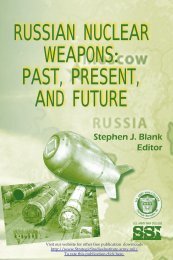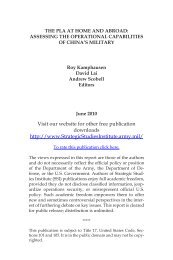Warriors in Peace Operations - Strategic Studies Institute - U.S. Army
Warriors in Peace Operations - Strategic Studies Institute - U.S. Army
Warriors in Peace Operations - Strategic Studies Institute - U.S. Army
You also want an ePaper? Increase the reach of your titles
YUMPU automatically turns print PDFs into web optimized ePapers that Google loves.
Although the setup had changed <strong>in</strong> the CP, and it<br />
appeared to be organized more on functional l<strong>in</strong>es, some<br />
th<strong>in</strong>gs had not changed <strong>in</strong> the last month. The long l<strong>in</strong>e of<br />
briefers paraded <strong>in</strong> front of the CG were asked very tough<br />
questions; many did not know the answers. The very<br />
evident frustration was not much different from what I had<br />
seen <strong>in</strong> November. Aga<strong>in</strong>, the staff was whipped, except now<br />
the deployment was a matter of be<strong>in</strong>g a few days away.<br />
That night Major Tracy and I worked well past<br />
midnight, try<strong>in</strong>g to determ<strong>in</strong>e the best way to organize the<br />
DOC. There was the basic housekeep<strong>in</strong>g task of gett<strong>in</strong>g the<br />
assigned rooms organized to become a command and control<br />
center. Then there was the issue of creat<strong>in</strong>g track<strong>in</strong>g charts,<br />
phone rosters of key po<strong>in</strong>ts of contact, and determ<strong>in</strong><strong>in</strong>g<br />
what elements of <strong>in</strong>formation we needed to track and how<br />
<strong>in</strong>formation flow would occur. We determ<strong>in</strong>ed we would<br />
need more personnel to help us run the operation. We also<br />
decided we needed primarily to track tra<strong>in</strong>s. Eventually, we<br />
learned we also needed to track aircraft, buses, and convoys.<br />
The next day, <strong>in</strong> anticipation that we would get a<br />
deployment order immediately after the sign<strong>in</strong>g of the<br />
Dayton Accords (officially the General Framework<br />
Agreement for <strong>Peace</strong>), we cont<strong>in</strong>ued to deploy the “enabl<strong>in</strong>g<br />
forces.” These were units that would set up deployment<br />
nodes along the way. These forces would assist units deploy<br />
<strong>in</strong>to the Area of Responsibility (AOR) as soon as we received<br />
the deployment order.<br />
On December 14 we cont<strong>in</strong>ued to learn more about how<br />
the deployment system was supposed to work. The more we<br />
learned, the more we realized how convoluted the system<br />
was. I saw a fasc<strong>in</strong>at<strong>in</strong>g chart about this time.<br />
The Battle Command Tra<strong>in</strong><strong>in</strong>g Program had sent a team<br />
from Fort Leavenworth to observe the division and give us<br />
some assistance. General (Retired) L<strong>in</strong>dsey, the head of the<br />
team, visited the embryonic Deployment <strong>Operations</strong> Center<br />
about this time. He showed me a chart the team had created<br />
which graphically described the deployment process. There<br />
100
















